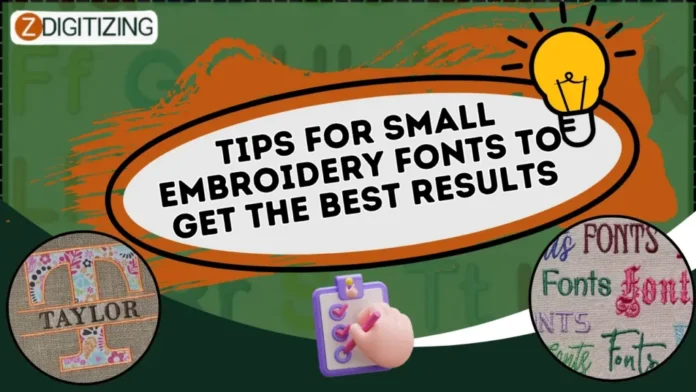Embroidering small fonts can be challenging, but with the right techniques and tools, you can achieve stunning results that enhance the overall quality of your embroidery projects. In this guide, we’ll share valuable tips for embroidering small fonts effectively, leveraging embroidery file format converters and digitizing services to optimize your designs for precision and clarity.
1. Choose the Right Font
When embroidering small fonts, selecting the appropriate font is crucial for readability and visual impact. Opt for fonts specifically designed for embroidery, with clear, defined lines and minimal intricate details. Sans-serif fonts often work best for small-scale embroidery due to their simplicity and legibility.
2. Increase Letter Spacing
To improve legibility and prevent letters from blending together, consider increasing the spacing between individual letters when embroidering small fonts. This allows each letter to stand out distinctly, ensuring clear readability even at smaller sizes. Experiment with different spacing adjustments until you find the optimal balance for your design.
3. Use Thicker Thread
Embroidering small fonts with thicker thread can help enhance visibility and definition, especially when working with intricate designs or delicate fabrics. Thicker thread creates bolder, more prominent lettering that stands out against the fabric background, making it easier to read from a distance. Experiment with different thread weights to find the best option for your embroidery project.
4. Optimize Stitch Density
Adjusting stitch density is essential for achieving crisp, well-defined small fonts in embroidery. Increase stitch density for smaller fonts to ensure that stitches are closely packed together, minimizing gaps and improving overall coverage. Digitizing services can assist in optimizing stitch density for small-scale embroidery designs, ensuring consistent results across different font sizes.
5. Use High-Quality Stabilizers
Proper stabilization is key to preventing distortion and puckering when embroidering small fonts. Use high-quality stabilizers that provide adequate support and stability for delicate fabrics. Consider using a combination of tear-away and cut-away stabilizers to ensure optimal stability without leaving behind visible residue.
6. Adjust Machine Settings
Fine-tuning machine settings such as tension, speed, and needle size can significantly impact the quality of small-font embroidery. Lowering machine speed and using a smaller needle size can help achieve finer details and sharper lines, particularly when working with intricate fonts or intricate designs. Experiment with different settings to find the optimal configuration for your specific embroidery project.
7. Test on Scrap Fabric
Before embroidering small fonts on your final project, always conduct test stitches on scrap fabric to evaluate the results and make any necessary adjustments. Testing allows you to assess stitch quality, thread tension, and overall legibility before committing to the final embroidery. It also provides an opportunity to fine-tune settings and techniques for optimal performance.
8. Avoid Complex Outlines
When embroidering small fonts, avoid using complex outlines or decorative elements that can detract from readability. Keep the design clean and straightforward, focusing on clear, well-defined letter shapes. Simplify intricate details and avoid excessive embellishments to ensure that the text remains legible, even at smaller sizes.
9. Consider Reverse Lettering
In some cases, reverse lettering (also known as negative space lettering) can be an effective technique for enhancing the visibility of small fonts. By stitching the background around the letters instead of the letters themselves, you create a contrasting outline that makes the text stand out against the fabric background. Experiment with reverse lettering to see if it improves the readability of your small-font embroidery designs.
10. Utilize Professional Digitizing Services
For intricate or challenging small-font embroidery projects, consider utilizing professional digitizing services to ensure optimal results. Digitizing experts have the expertise and specialized software to optimize designs for small-scale embroidery, including adjusting stitch settings, optimizing letter shapes, and fine-tuning details for clarity and precision. Utilize embroidery file format converters to translate your designs into stitch-ready files compatible with embroidery machines, ensuring seamless integration of small fonts into your embroidery projects.
By incorporating these tips and techniques into your small-font embroidery projects, you can achieve exceptional results that elevate the quality and visual impact of your designs. With careful attention to detail and the right tools at your disposal, embroidering small fonts can be a rewarding and satisfying endeavor.





